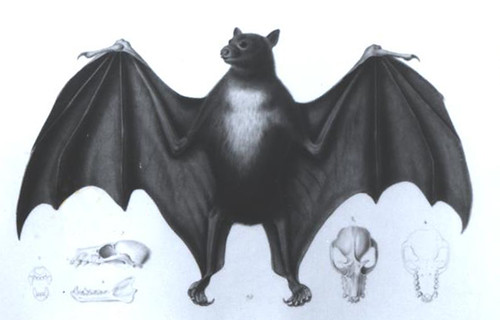Scientific name: Pteropus mariannus
Bats in the old World family Pteropodidae have very large eyes and excellent eyesight in low light, but do not use echolocation. Within the Pteropodidae family, bats in the genus Pteropus are known as flying fox because their face and ears resembles a fox or small dog. The bats found on Guam are Pteropus mariannus, locally called fanihi or fruit bats.
Pteropus marianus is a medium sized flying fox. The males are slightly larger than females. Adult bats weigh 0.66 to 1.15 pounds and have a forearm length 5.3 to 6.1 inches. The fur is dark brown in color and often flecked with gray hairs giving the bats a grizzled appearance. Fur at the shoulders and neck is longer and paler brown or golden in color.
The range of fanihi is limited to the Marianas and Caroline islands: Guam, Rota, Saipan, Tinian, Agrihan, Sarigan, Anatahan, Pagan, Guguan, Maug, Asuncion, Palau, Yap, Ulithi, and Kosrae.
Roosts, reproduction and social organization
Fruit bats roost in the canopy of large trees in colonies that can be made up of hundreds or thousands of bats using numerous trees. Bats return to the same colony sites for many years if they are not disturbed. When colonies are repeatedly bothered by hunters or other activities, bats will move to areas that are difficult for people to find such as at the edge of cliffs or in mangroves. A small number of bats typically roost away from colonies solitarily or in very small groups.
Mature males are thought to defend females from other males in a “harem” social organization, where bachelor males roost in trees around the main colony. Females give birth to a single pup annually. Bats are born throughout the year and remain near their mother for up to a year. It is thought that the wild bats live between five to eight years.
Foraging and foods
Fruit bats feed on fruit, nectar, and young leaves, native forest species are preferred to introduced plants. Fruits that are commonly eaten include:
| Scientific name | CHamoru name | English name |
|---|---|---|
| Artocarpus mariannensis | dukduk | breadfruit |
| Cycas circinalis | fadang | Federico nut, cycad |
| Ficus prolixa | nunu | banyan, strangling fig |
| Neisosperma oppositifolia | fagot | |
| Pandanus fragrans | kafu | pandanus screw pine |
| Terminalia catappa | talasi | tropical almond |
Bats also visit flowers for nectar in particular Barringtonia asiatica, or putting in CHamoru, and sea poison tree or fish poison tree in English; and Erythrina variegata, or gaogao in CHamoru, and Indian coral tree in English. Tender young leaves, shoots and buds are regularly eaten and are an important food sources after typhoons.
Three bats, carrying small radio collars, were followed in Guam’s northern forests of Andersen Air Force Base. They had a distinct foraging area that were used repeatedly, ranging in size from 35 acres to 270 acres. Two of the bats commuted nightly from roosting sites to foraging areas a distance of about three miles. The third bat both roosted and foraged in the same area. The bats foraged in both mature and secondary growth limestone forest.
Threats, population sizes and status
The number of bats on Guam and in the Commonwealth of the Northern Mariana Islands has declined drastically in recent years. The US Fish and Wildlife Service has listed fanihi as a threatened species. The Convention on International Trade in Endangered Species (CITES) lists Mariana fruit bat as an Appendix 1 species meaning “threatened with extinction.”
Scientists estimate that there are less than forty fanihi remaining on Guam. The single fanihi colony at Pati Point on Andersen Air Force Base has less than 40 bats at a count in May 2015. Illegal hunting and predation by brown treesnakes are the greatest threats to fanihi on Guam. Illegal hunting on Rota has greatly reduced the population. There are few fanihi on Saipan, Tinian and Agrihan. The eruption of the volcano on the island of Anatahan in 2003-2005 reduced that island’s bat population from over 1,000 fanihi to an estimated 100 in 2007. Approximately 150 fanihi are on Sarigan. There have been no recent counts on the far northern islands.
From 1970 to 1990, a yearly average of 13,000 fanihi were imported from islands across the Pacific for sale in markets on Guam. More than 220,000 fanihi were killed during this time, resulting in enormous loss of fanihi populations in countries from Palau to Samoa. Samoa has two species of fruit bats, Pteropus tonganus and Pteropus samoensis, which are different from the species found on Guam, the CNMI and Caroline islands.
Fanihi numbers on some islands have never recovered as the populations were driven to such low numbers that even small amounts of hunting are unsustainable. International trade in bats was prohibited in 1990 among countries that are signatory to CITES, (Convention on International Trade in Endangered Species of Wild Fauna and Flora) which is an international agreement between governments. Its aim is to ensure that international trade in specimens of wild animals and plants does not threaten their survival.
Visit a Fanihi
The Cushing Zoo
For further reading
Hall, Leslie, and Greg Richards. Flying Foxes: Fruit and Blossom Bats of Australia. Melbourne: Krieger Publishing Company, 2001.
US Fish and Wildlife Service. “Mammals.” Pacific Islands Fish and Wildlife Office Exploring Species.
US Fish and Wildlife Service Pacific Islands Fish and Wildlife Office. “Mariana Fruit Bat (Pteropus mariannus mariannus).” Endangered and Threatened Wildlife and Plants Federal Registry. 70 FR 1190. Honolulu: PIFWO, 2005.
Wiles, Gary J., and Anne P. Brooke. “Conservation Threats to Bats in the Pacific Islands and Insular Southeast Asia.” Ecology, Evolution, and Conservation of Island Bats. Edited by Theodore H. Fleming and Paul A. Racey. Chicago: University of Chicago Press, 2009.






